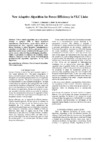Identificador persistente para citar o vincular este elemento:
https://accedacris.ulpgc.es/jspui/handle/10553/107075
| Campo DC | Valor | idioma |
|---|---|---|
| dc.contributor.author | Rabadán Borges, José Alberto | en_US |
| dc.contributor.author | Guerra Yánez, Víctor | en_US |
| dc.contributor.author | Rufo Torres, Julio Francisco | en_US |
| dc.contributor.author | Pérez Jiménez, Rafael | en_US |
| dc.date.accessioned | 2021-05-03T09:02:51Z | - |
| dc.date.available | 2021-05-03T09:02:51Z | - |
| dc.date.issued | 2018 | en_US |
| dc.identifier.uri | https://accedacris.ulpgc.es/handle/10553/107075 | - |
| dc.description.abstract | Power control algorithms are a well-known strategy to optimize SNR in highly interfered environments. Furthermore, sensor nodes, which are battery-powered, have expensive replacement costs. Hence, strategies to reduce the power consumption are mandatory in this kind of device, and power control algorithms can be energy-optimized. In this paper, a new power control, Adaptive-Step-and-Damping algorithm - ASDA- is presented. It enhances the resulting energy efficiency compared with the classic Newton-Raphson gradient-descent algorithm (equivalent to an LMS algorithm) | en_US |
| dc.language | eng | en_US |
| dc.publisher | Institute of Electrical and Electronics Engineers (IEEE) | en_US |
| dc.source | 14th International Wireless Communications and Mobile Computing Conference (IWCMC), p. 684-689 | en_US |
| dc.subject | 3325 Tecnología de las telecomunicaciones | en_US |
| dc.subject.other | Energy efficiency | en_US |
| dc.subject.other | Power Control Algorithm | en_US |
| dc.subject.other | VLC isolated nodes | en_US |
| dc.title | New adaptive algorithm for power efficiency in VLC links | en_US |
| dc.type | info:eu-repo/semantics/conferenceobject | en_US |
| dc.type | ConferenceObject | en_US |
| dc.relation.conference | International Wireless Communications and Mobile Computing Conference (IWCMC 2018) | en_US |
| dc.investigacion | Ingeniería y Arquitectura | en_US |
| dc.type2 | Actas de congresos | en_US |
| dc.utils.revision | Sí | en_US |
| dc.date.coverdate | JULIO 2018 | en_US |
| dc.identifier.ulpgc | Sí | en_US |
| dc.contributor.buulpgc | BU-TEL | en_US |
| dc.description.ggs | 3 | |
| item.fulltext | Con texto completo | - |
| item.grantfulltext | open | - |
| crisitem.event.eventsstartdate | 25-06-2018 | - |
| crisitem.event.eventsenddate | 29-06-2018 | - |
| crisitem.author.dept | GIR IDeTIC: División de Fotónica y Comunicaciones | - |
| crisitem.author.dept | IU para el Desarrollo Tecnológico y la Innovación | - |
| crisitem.author.dept | Departamento de Señales y Comunicaciones | - |
| crisitem.author.dept | GIR IDeTIC: División de Fotónica y Comunicaciones | - |
| crisitem.author.dept | IU para el Desarrollo Tecnológico y la Innovación | - |
| crisitem.author.dept | GIR IDeTIC: División de Fotónica y Comunicaciones | - |
| crisitem.author.dept | IU para el Desarrollo Tecnológico y la Innovación | - |
| crisitem.author.dept | GIR IDeTIC: División de Fotónica y Comunicaciones | - |
| crisitem.author.dept | IU para el Desarrollo Tecnológico y la Innovación | - |
| crisitem.author.dept | Departamento de Señales y Comunicaciones | - |
| crisitem.author.orcid | 0000-0002-9994-4495 | - |
| crisitem.author.orcid | 0000-0002-6264-7577 | - |
| crisitem.author.orcid | 0000-0002-2269-6729 | - |
| crisitem.author.orcid | 0000-0002-8849-592X | - |
| crisitem.author.parentorg | IU para el Desarrollo Tecnológico y la Innovación | - |
| crisitem.author.parentorg | IU para el Desarrollo Tecnológico y la Innovación | - |
| crisitem.author.parentorg | IU para el Desarrollo Tecnológico y la Innovación | - |
| crisitem.author.parentorg | IU para el Desarrollo Tecnológico y la Innovación | - |
| crisitem.author.fullName | Rabadán Borges, José Alberto | - |
| crisitem.author.fullName | Guerra Yanez, Victor | - |
| crisitem.author.fullName | Rufo Torres,Julio Francisco | - |
| crisitem.author.fullName | Pérez Jiménez, Rafael | - |
| Colección: | Actas de congresos | |
Visitas
137
actualizado el 01-mar-2025
Descargas
56
actualizado el 01-mar-2025
Google ScholarTM
Verifica
Comparte
Exporta metadatos
Los elementos en ULPGC accedaCRIS están protegidos por derechos de autor con todos los derechos reservados, a menos que se indique lo contrario.
